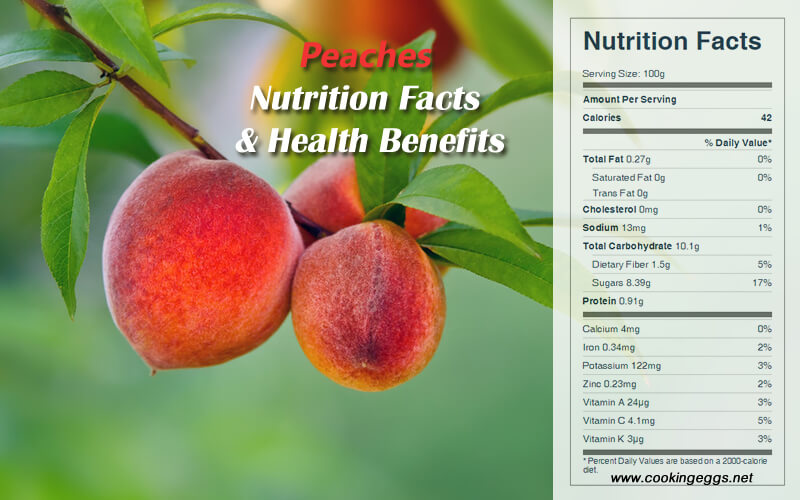Peaches Nutrition Facts & Health Benefits
Peaches are a low-calorie and very juicy fruit. Besides being incredibly tasty, peaches provide several health benefits. Here is the nutrition value of peaches.
Peaches are sweet and juicy. They are rich in betacarotene, vitamin C, calcium, boron, magnesium, phosphorus, potassium, and flavonoids.

Nutritional Composition of Peaches
One medium raw peach provides 37 calories, 9.7 g carbohydrate, 0.6 g protein, 0.1 g fat, 2 g dietary fiber, 465 IU vitamin A, 6 mg vitamin C, 3 mcg folic acid, 171 mg potassium, 4 mg calcium, 10 mg phosphorus, and 6 mg magnesium.
Raw peach flesh is 88% water, 10% carbohydrates, 1% protein, and contains negligible fat.
Peaches Nutrition Facts Label
Health Benefits of Peaches
Peaches are a good source of water in hot weather. Another benefit is their high potassium content, which helps regulate hydration and can therefore help you avoid muscle cramps. Peaches also have a reputation as a laxative, courtesy of the combination of high fiber and high water content.
Vitamin C and vitamin A contribute to their antioxidant ability and eliminate free radicals that have a negative effect on our health. Peaches are also a good source of vitamins A and C, beta-carotene, and lutein—all beneficial to preserving vision.
In the lab, extracts from peaches have slowed the growth of some types of breast and colon cancer cells. In a National Cancer Institute study, people who consumed more peaches and related fruits, such as nectarines and plums, were less likely to develop cancers of the mouth, throat, or larynx.
Several bioactive constituents are higher in the peel than in the pulp, so you want to be sure to eat that too to gain the greatest antioxidant and anti-inflammatory benefits.
The phenolic compounds, carotenoids, and tocopherols can affect overall health. Antioxidant polyphenols found in peaches include lutein, zeaxanthin, and betacryptoxanthin. The peel extract has been found to contain higher amounts of phenolics, anthocyanins, and flavonols. (Every fruit is different: If we compare peaches to apricots, we find the opposite: the benefit is found more in the pulp than in the skin.) In addition, cyanidin is the main pigment that gives peaches their red tone, and cyanidin-3-glucoside is the main anthocyanin reported in peaches.
The presence of polyphenols increases as peaches ripen. Interestingly, antioxidants are also higher as the peach ripens (as opposed to early and mid-season). Peaches have antioxidant and anti-inflammatory benefits, and the fiber is essential to our overall health, well-being, and gut! The more strongly colored peaches had more anthocyanins, polyphenols, and antioxidants, and yellow-fleshed peaches had more carotenes. This is not surprising since these nutrients also add color to fruit.
Health Risk
Peach allergy or intolerance is a relatively common form of hypersensitivity to proteins contained in peaches and related fruits such as almonds. Symptoms range from local effects (e.g., oral allergy syndrome, contact urticaria) to more severe systemic reactions, including anaphylaxis, such as urticaria, angioedema, and gastrointestinal and respiratory symptoms.
As with many other members of the rose family, peach seeds contain cyanogenic glycosides, including amygdalin. These substances are capable of decomposing into sugar molecules and hydrogen cyanide gas. Cyanogenic glycosides are toxic if consumed in large doses. While peach seeds are not the most toxic within the rose family (see bitter almond), large-scale consumption of these chemicals from any source is potentially hazardous to animal and human health.